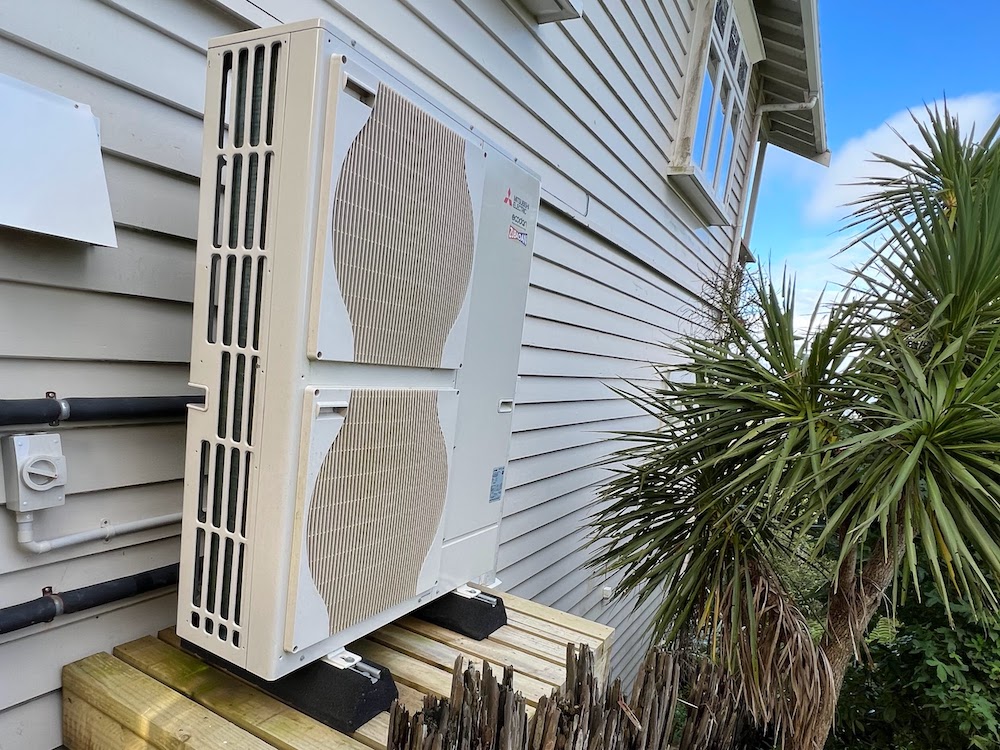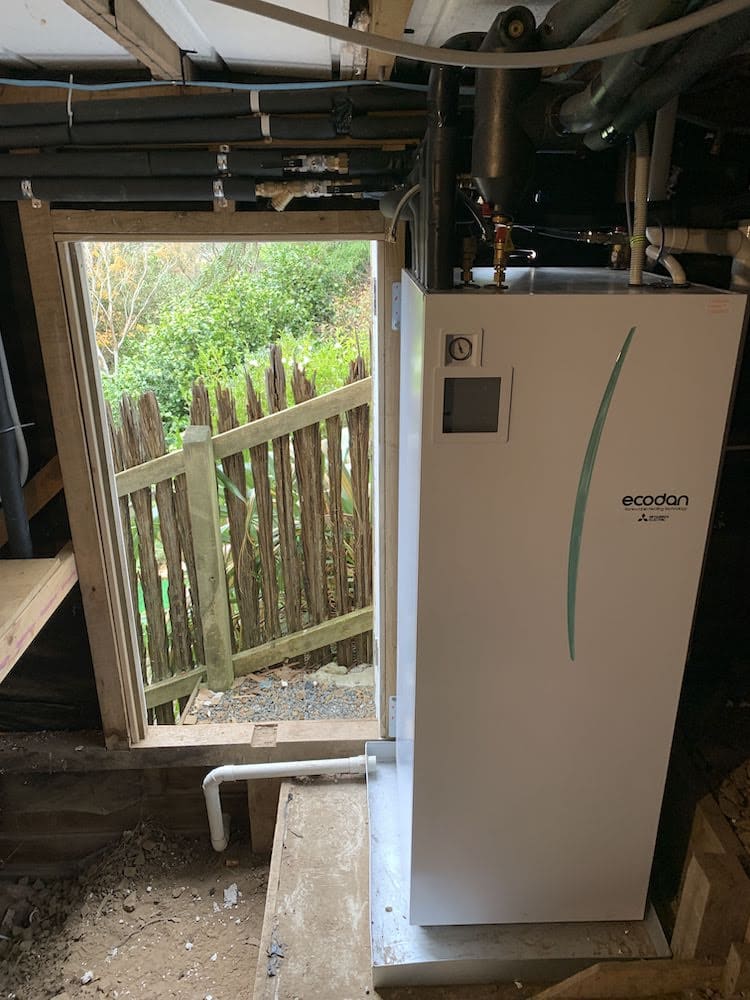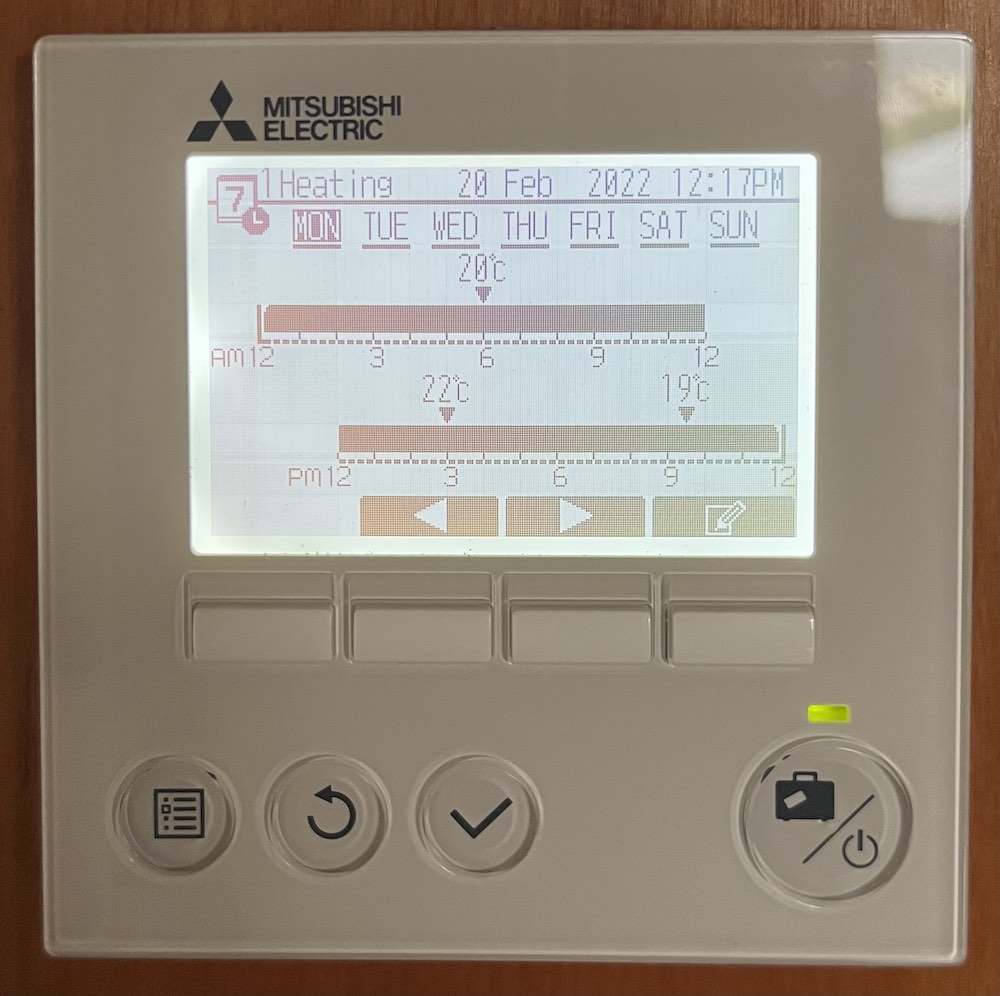Review of the Mitsubushi Ecodan
20 February 2022
The Mitsubushi Ecodan is a heat pump solution that heats hot water. The hot water is used for two purposes:
- Domestic hot water - this is for showers, baths and hot water taps.
- Central heating - the water is pumped through radiators to warm individual rooms.
The Ecodan solution replaced our two existing gas-powered systems - an ancient Rennai Instant hot water boiler, and an aging gas central heating boiler. The new Ecodan was connected to the existing pipes and radiators.
Components
There are three main components to the solution - the external fan unit, an internal hot water cyclinder box and the radiators.
External fan unit
The external fan unit looks similar to a regular heat pump fan, but is a little taller. Because we live on a hill, ours needed to be mounted on a wooden platform.

Internal hot water cylinder unit
This rectangular unit contains a 200 litre hot water storage cylinder. It also contains various pipes and valves that connect up to our existing internal hot water pipes, and also to the radiator pipes.
The unit sits on a concrete pad in the basement area under our house. Two large pipes run from this unit to the exterior fan unit.

Operation
The entire system is controlled from a control panel mounted in our hallway.

The system is very flexible, and allows you to adjust almost every aspect of the operation. The settings that we have adjusted are…
Hot water temperatures and schedule
You can adjust at what times of day you want the system to “make hot water”. This can be 24 hours a day, or whenever you desire. As we have solar PV, it makes sense to generate hot water while the sun is high in the sky. So, we have the schedule set to start around 11 am for 3 hours. We have another block set to heat the hot water after midnight, while both electricity prices are lower, and CO2 emitting electricity generation is unlikely to be used.
You can enable “eco mode” that heats the water slower. This results in the fan unit operating at a gentle pace (also quieter), and this in turn results in a more efficient heating outcome. And that means that less electricity is used to make the same amount of hot water, and that reduces you energy bill at the end of the month.
A full re-heat of the tank takes around an hour on eco mode.
You can adjust the desired hot water temperature too. A higher temperature means more hot water. A lower temperature means more efficient generation. We have ours set to 55 degrees.
House temperatures (radiators) and schedule
On the summer schedule, we expect the system to do very little heating - the weather is normally warm. But, we do live in a city that can occasionally get cold - so we have a minimum temperature set to 19 degrees overnight and 20 during the day. Evenings are set to 22 degrees.

On the winter schedule, we pretty much have the same settings - but we have the temperature set to a little higher during weekend daytime.
In a similar manner to the domestic hot water temperature setting, you can also adjust the maximum temperature of the water in the radiators. This maximum temperature really only applies when the system is working very hard (extremely cold night, or re-heating the house from cold).
We have set our maximum radiator temperature to 45 degrees.
Behaviour
Hot water based heat pumps work in a similar manner to ordinary “hot air” heat pumps. As the temperature of the house is getting close to the target temperature, the system slows down. In practice, this means that the heat of the radiators adjusts to “mildly warm”. The inside temperature remains fairly constant.
This is quite different from our previous gas-powered central heating. That seemed to be in an either “all on” or “all off” state, meaning that the radiators were either very hot or “off” (cooling down). The end result was that the inside temperatures tended to flutuate up and down.
Noise
The interior hot water cylinder unit is essentially silent. I believe it does have pumps inside it, but I have never heard any noises coming from it.
The exterior fan unit does make noise. But, it is more a vibration rather than a noise. It can be heard in the dead of night, when there are no other sounds about. I think our issue is that the stand on which the fan unit is mounted, is directly attached to the house. I suspect the vibration travels into the house this way. If I was doing this a second time, I would mount the fan on a detached stand, and thus avoid the transfer of the vibration.
As for sound - the exterior unit does make “fan noises”, but it is very quiet. Our neighbour’s “normal sized” heat pump fan makes more noise that the Ecodan “double sized” unit - but, they are both very quiet.
Comfort
It is very comfortable, with a more consistent heat level that we previously had with our gas powered central heating. Because the running costs are so low, we never hesitate to turn up the heat if we are feeling cold.

Costs
Running costs
The total energy consumption for the year 2021 was 5,456 kWh. At 30c per kWh, that works out at $1,636 for the whole year. Or an average of $136 per month. And this is for a 94 year old house where we keep the internal temperature above 19 degrees day and night.
In reality, our running costs are substantially lower. Our solar PV means daytime usage is often free.
The overall COP for 2021 was 3.1.
Purchase & installation costs
We paid $18,000 for the purchase, and $4,500 for the installation (including building work).
Summary
We are delighted with this product - it has made our home comfortable year round, with a small energy bill. It has allowed us to disconnect from the gas network and reduce our CO2 emissions.
Would I recommend the Ecodan hot-water heat pump solutions to others?
Yes.
Related posts
- My Tesla Powerwall Experience
- All about solar panels
- Four years of household energy costs and emissions
- Comparison of fossil-fuel with electric-only energy costs for spring
- Household energy costs comparison for winter
- Price Comparison of Electricity and Gas
- Energy efficiency after 1 week
- Conversion of gas central heating to electric
- Recording our carbon footprint at home
- Please don’t wait for the Politicians